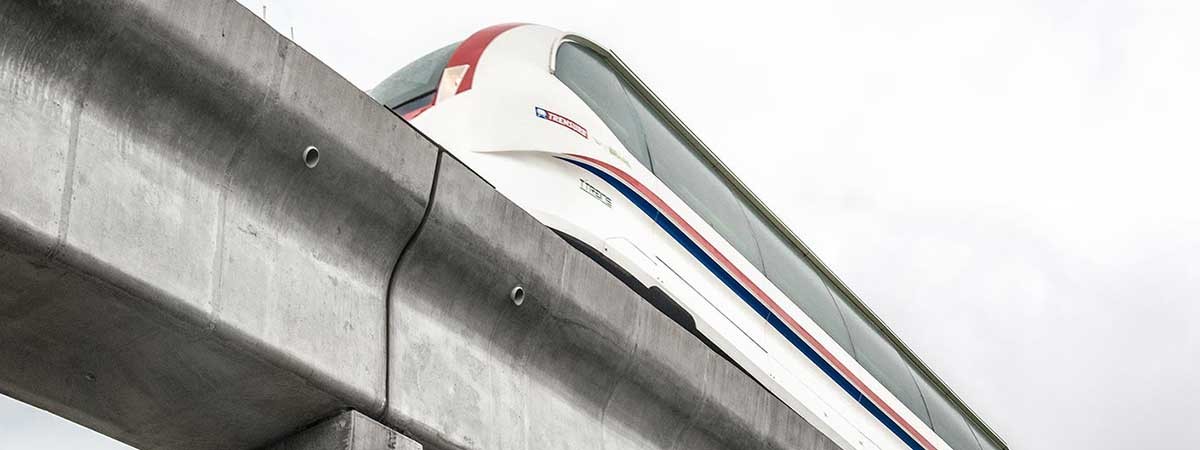Apart from bicycles, all means of transport are heavier than the loads they carry. If this were not the case, the energy employed would be utilized much more efficiently. This is exactly what happens with the atmospheric railway, which is driven by vacuum pumps.
A car, even if it is a compact car, weighs significantly more than a ton today. Even if it carries two people, almost ninety percent of the energy is still needed to move the vehicle alone. In this example, passengers account for barely more than ten percent. The ratio between payload and vehicle weight rarely rises above 1:4, even when fully loaded. We find similarly unfavorable conditions with airplanes, and much worse with railways.
Omitting the on-board drive
One of the heaviest parts in conventional vehicles is always the drive. Bicycles only achieve their high efficiency because the passenger also acts as the drive. But does the motor really have to travel along? It would be much better to install it somewhere en route and transfer its power to the vehicle over the distance. This was the idea engineers had in the century before last. The first atmospheric railway lines were built in the 1840s in Ireland and England.
The basic idea is simple: a pipe is laid between the rails with a slot at the top with a flexible seal. Inside the pipe there is a piston that almost completely fills the diameter of the pipe. It is fastened to the underside of the train carriage and the connection between the two is created through the seal on the pipe slot. A vacuum pump builds up a vacuum in front of the train. The piston is pulled in this direction and pulls the vehicle with it. On the back, a compressor with overpressure can assist.
Success on second attempt
In the 19th century, material and technology had not yet reached the level required for sufficiently sealing the pipe slot and efficiently operating the vacuum pumps. These problems have now been solved thanks to modern technology. The Brazilian engineer Oskar Coester was thus able to develop the Aeromovel, an air-propelled vehicle, in the 1970s. This transport system operates according to the same principle as the 19th century atmospheric railway.
The modern version has a rectangular shaft between the rails instead of a round pipe and a rectangular drive plate inside instead of a piston. The power of the stationary pumps is used both for the vacuum in front of the train and for the overpressure behind it. A test vehicle was driven at the Hanover trade show in 1980. There are currently two Aeromovels in operation: a 3.2-kilometer-long circular railway in an Indonesian theme park and a 1000-meter-long railway at the airport in the Brazilian city of Porto Alegre. Further installations are planned. The ratio between payload and vehicle weight reaches the potential record-breaking value of 1:1 when the Aeromovel is fully loaded.

Airy Drive for Light Trains
Rolling stock with vacuum drive
What prevented the success of the first attempt at creating an atmospheric railway?
There was actually a lot to be said for this early alternative to the steam locomotive, which had to carry large quantities of hard coal in addition to the tonnage of its own weight. On the London-Croydon route, the atmospheric railway there reached a maximum speed of 160 kilometres per hour in 1845. This record was not beaten by a steam locomotive until almost 60 years later. Nevertheless, the operation of all atmospheric routes was mostly stopped after a short time.
A decisive weak point was the sealing of the pipe slot. It usually consisted of ox leather, which was lubricated with soap, cod liver oil and similar substances. However, the leather became hard and brittle when there was frost. In addition, the lubricants used attracted rats, which gnawed away at the seal. Without signalling technology that could track the train, the steam engines for the vacuum pumps, which were already inefficient, worked strictly according to schedule. In the case of delayed trains, even more coal was consumed unnecessarily. Some of the trains also had difficulties starting up and stopping at the platform with pinpoint accuracy. The sum of the disadvantages and the progress made with steam locomotives therefore put a temporary end to this promising technology.
There was actually a lot to be said for this early alternative to the steam locomotive, which had to carry large quantities of hard coal in addition to the tonnage of its own weight. On the London-Croydon route, the atmospheric railway there reached a maximum speed of 160 kilometres per hour in 1845. This record was not beaten by a steam locomotive until almost 60 years later. Nevertheless, the operation of all atmospheric routes was mostly stopped after a short time.
A decisive weak point was the sealing of the pipe slot. It usually consisted of ox leather, which was lubricated with soap, cod liver oil and similar substances. However, the leather became hard and brittle when there was frost. In addition, the lubricants used attracted rats, which gnawed away at the seal. Without signalling technology that could track the train, the steam engines for the vacuum pumps, which were already inefficient, worked strictly according to schedule. In the case of delayed trains, even more coal was consumed unnecessarily. Some of the trains also had difficulties starting up and stopping at the platform with pinpoint accuracy. The sum of the disadvantages and the progress made with steam locomotives therefore put a temporary end to this promising technology.